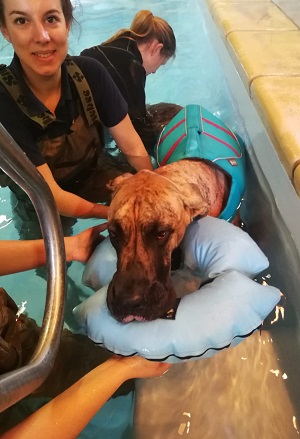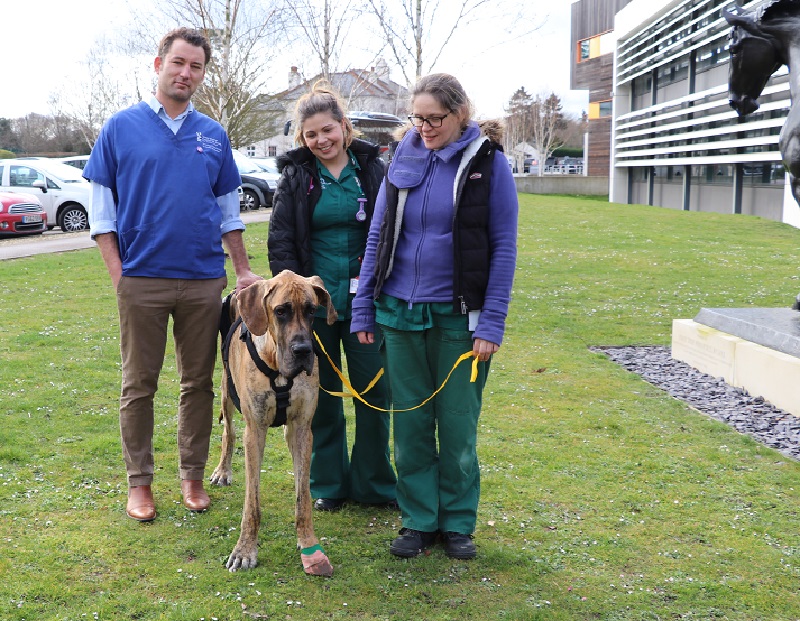Belgian Great Dane Travels to the RVC for Exceptional Care
Clinical Connections – Summer 2019
Steven De Decker, Head of Neurology and Neurosurgery
I was contacted last December by Gustav’s owner, who lives near Brussels. Gustav was diagnosed in Belgium with osseous-associated cervical spondylomyelopathy (OA-CSM), a specific form of ‘wobbler syndrome’. It is a challenging neck problem that most often affects young Great Danes.
Gustav’s owner contacted me because I completed a PhD on cervical spondylomyelopathy several years ago and my name still seems to be internationally associated with the condition. The owner found my name and that of a neurologist and neurosurgeon at Ohio State University when doing an internet search for the condition.

Although the owner of Gustav contacted me because of my recognition as a ‘wobbler-expert’, the reason I advised them to come was for the aftercare Gustav would receive here if he had surgery. The most important reason for Gustav to travel from Belgium to the RVC was our team of neurology and rehabilitation nurses. This team is unparalleled. I cannot imagine another institution in the world that has such a large and specialised team of veterinary neurology nurses, including a qualified physiotherapist.
Looking after a non-ambulatory 77kg Great Dane is extremely challenging and all credit should go to the nurses. I normally advise these international clients to go to a local/national specialist centre or vet school, but I was concerned it would be too challenging to do the postoperative care.
Gustav, who was 18 months when he came to the RVC in January, was unfortunately getting worse and so his owner had been considering surgery. Surgery for OA-CSM is challenging and owners need to be well prepared.
In contrast to other forms of cervical spondylomyelopathy, there is little controversy or discussion about the selection of the most appropriate surgical technique. The surgical technique – continuous dorsal cervical laminectomy – can be complicated by the size of the patient and the anatomic abnormalities often seen in this condition.
The most challenging aspect of having the surgery is the aftercare. Even if the surgery goes well, it is likely that dogs are much worse immediately afterwards. This is the most common complication after performing a dorsal cervical laminectomy and occurs in 70-80% of dogs treated for osseous-associated cervical spondylomyelopathy. RVC research has demonstrated that the biggest risk factor for this ‘early postoperative deterioration’ is having a diagnosis of cervical spondylomyelopathy. This complication occurs significantly less when we perform the same surgery for another condition.
This postoperative deterioration is fortunately only transient. Most dogs will still experience a successful long-term recovery. Recent research at the RVC has demonstrated that we see a successful outcome in 94% of our cases, despite seeing obvious neurological deterioration in 70% of dogs treated surgically for OA-CSM.
It is therefore clear that appropriate care during the immediate postoperative period forms the biggest challenge to obtain a successful long-term outcome in dogs with OA-CSM. A combination of appropriate nursing care and intense physio and hydrotherapy are of uttermost importance in these patients to prevent complications and maximise the chances of a successful outcome.
The owner was very well prepared that Gustav would not be able to walk after surgery and that he would be hospitalised for a prolonged period of time. As the owners have some health problems themselves, he had to stay at the RVC until he could rise up and walk without any assistance. It was always the plan that he would stay for several weeks.
Since returning home Gustav has been doing very well. The owner keeps me updated and sent me some video of him running and playing in the garden with their other dog. You can see footage of Gustav before and after treatment here.

